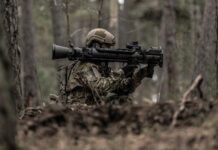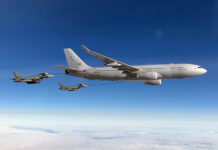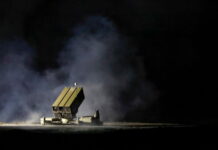NATO’s Next Generation Rotorcraft Capability (NGRC) programme aims to refresh the aviation fleets of participating member states with an advanced medium-lift multi-role helicopter.
Goal of the Programme
A significant portion of the medium-lift multi-role helicopter fleets of Alliance members will reach the end of their service life in the 2035-2040 timeframe, with additional airframes retiring during the following decade; overall, non-US NATO armed forces are expected to replace up to 1,000 medium-lift rotary aircraft by 2050. Traditionally, nations have pursued individual weapon system acquisition projects, either through domestic development of new aircraft or import of operational foreign systems. Numerous reasons exist for pursuing a joint acquisition programme instead. These include economies of scale, the ability to combine the most advanced design and manufacturing capabilities of the participating states, and the outlook for optimal interoperability of the future fleets.
NGRC was launched on 19 November 2020 with the signing of a non-binding Letter of Intent (LoI) to pursue the multinational development programme. The five signatories – France, Germany, Greece, Italy, and the United Kingdom (as the lead nation) – then proceeded to develop both a statement of requirements to guide the concept development phase, and a long-term multi-phase cooperation plan for realising the full project all the way through fielding. On 16 June 2022, the signatories, now joined by the Netherlands as a sixth partner, signed the binding Memorandum of Understanding (MoU).
This formally launched the concept stage of the project, with a combined initial budget commitment of EUR 26.7 M. Canada will join the programme in the summer of 2023, and additional NATO members may also come on board – most likely as observers – as the project progresses.
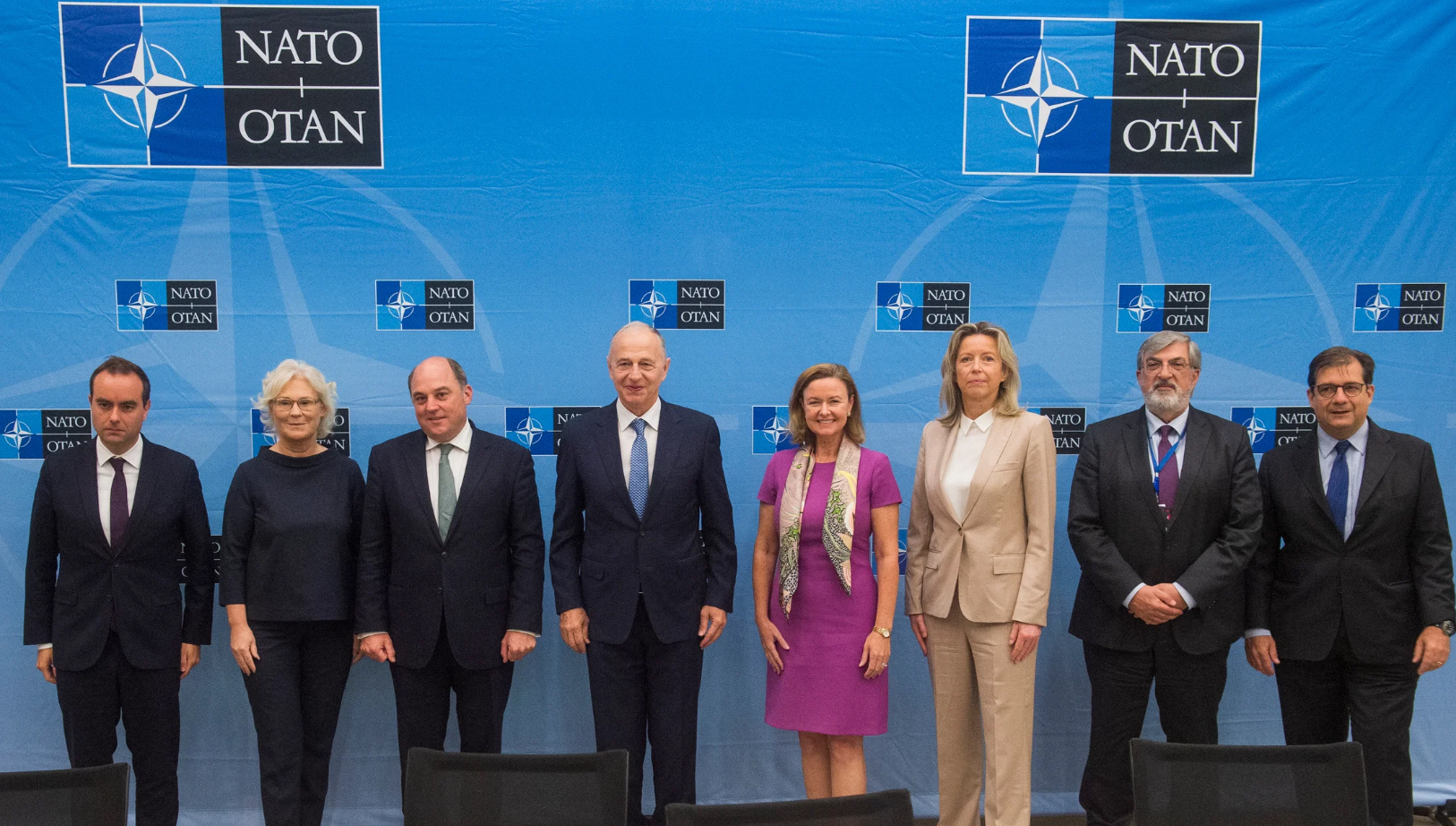
Credit: NATO
The NGRC programme will provide participating Alliance members a multinational framework for pooling their resources and efforts to design, develop, and eventually procure the new helicopters. The NGRC is classified as a NATO High Visibility Project (HVP), a term used for multinational initiatives designed to address key capabilities. HVPs are usually launched at the defence minister level, underscoring both the consensus regarding a major requirement, and enhancing the probability that member states are fully committed to the joint project.
The NATO Support and Procurement Agency (NSPA) acts as the contracting authority for the NGRC and is the executive arm of the NATO Support and Procurement Organisation (NSPO), of which all 31 Alliance nations are members. The NSPA is currently organising the concept study phase and providing programme management (procurement and finance); it will also devise and manage the acquisition strategy for upcoming stages. The agency’s Cyril Heckel is the official NGRC programme manager.
Roles, Missions, Capabilities
Today’s army and air force medium-lift helicopters perform a wide array of missions including assault carrier, special operations transport, battlefield resupply, combat search and rescue, and casualty evacuation/medical evacuation (CASEVAC/MEDEVAC); NGRC must be capable of fulfilling all of these roles. The future helicopter is also supposed to replace medium-lift helicopters in naval service, which means it must be capable of landing on decks and performing such tasks as anti-submarine warfare, maritime reconnaissance and targeting support, and potentially anti-surface warfare. The target aircraft should display significantly improved flight characteristics when compared to current operational systems.
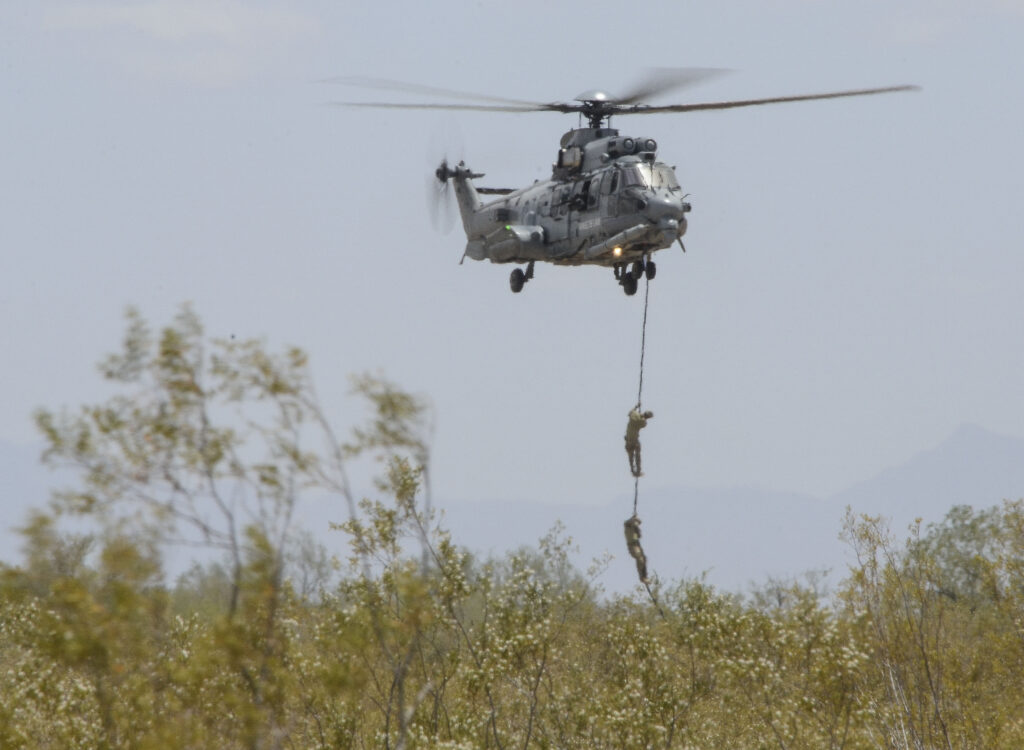
Credit: USAF
NSPA presented an initial list of 15 system requirements plus another ten desired attributes in May 2021 in preparation of an industry day in September 2021; these requirements and preferences were confirmed in February 2023 by programme manager Cyril Heckel during the IQPC International Military Helicopter (IMH) 2023 conference in London. Whether all requirements survive past the concept study – and the intense review of what is technically feasible – remains to be seen, but for now the agency is seeking an optionally-manned platform with a minimum range of 1667 km (900 NM), a 741 km (400 NM) mission radius, plus 30 minutes of loiter time, and an overall eight-hour mission endurance (with auxiliary tanks fitted).
The objective maximum cruise speed is 220 kn or higher, with 407 km/h (180 kn) as the absolute bottom threshold. These baselines would provide NGRC with approximately 50% more speed and double the range of current medium-lift utility helicopters, placing performance parameters closer to the US Army’s Future Long-Range Assault Aircraft (FLRAA); the American aircraft is expected to become fully operational at approximately the same time as NGRC. Being able to keep up with one another would of course be advantageous for future NATO operations.
The target take-off weight lies between 10,000 and 17,000 kg, with a 2,500 kg internal payload capacity and a combined internal/external payload of 4,000 kg. The acquisition price per airframe must not exceed EUR 35 M, and the hourly flight cost should lie between EUR 5,000 (objective) and EUR 10,000 (maximum). The aircraft must also have a 75% mission availability rate. As reiterated by Cyril Heckel during the IMH conference, all performance parameters are to be met with minimal differences in aircraft configuration in order to minimise complexity and cost.
Additional required goals are numerous and include: an internal capacity for 12–16 combat equipped soldiers; the ability to perform special operations, anti-surface warfare, electronic warfare (EW), search-and-rescue, personnel recovery and MEDEVAC missions; full-operational capability from frigate/destroyer type vessels; and being able to operate in the face of enemy EW threats. Desired attributes include: a two-minute automated rapid start routine; digital cockpit and avionics; aerial refuelling capacity; the ability to launch and control drones (manned-unmanned teaming); and deployment of advanced crew served weapons including missiles and so-called Air-Launched Effects, a blanket term which includes loitering munitions with a broad capability spectrum ranging from reconnaissance and surveillance to kinetic effects and EW.
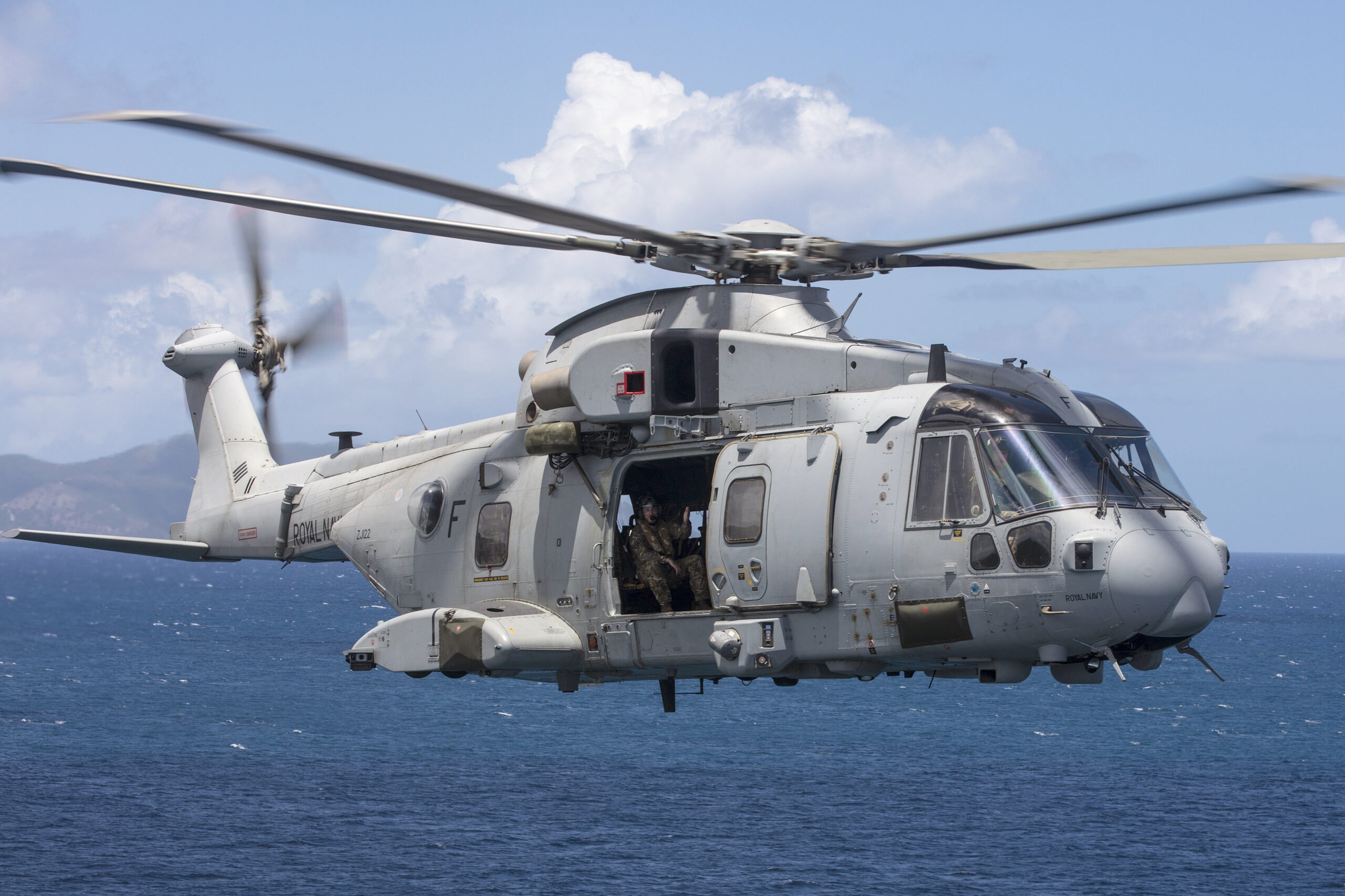
Credit: Royal Navy/Open Government Copyright
Programme Elements
As defined by NATO, NGRC offers a multinational framework under which its participants can combine efforts towards the design, development and eventually the acquisition of the next generation of medium multi-role rotorcraft capabilities. The plan is to create a clean-sheet design rather than adapting a currently operational or developmental aircraft. Working closely with industry, the governments will assess how to sync their operational requirements and desired aircraft characteristics with technological developments, as well as assessments of the future operating and threat environment. “NGRC to me is about transformation capability, delivering an aircraft or an airframe or a system that is an open system architecture based on digital backbones and is aimed for us as soldiers and airmen to be able to modify that aircraft to keep up with the pace of the threat,” said British Army Col. Alex Willman, capability sponsor of combat aviation within the UK’s futures directorate, after the MoU signing.
The programme’s concept study phase commenced in June 2022, and is subdivided into five major areas of interest. Studies are being prepared regarding the concept of operations, novel powerplant solutions (to review the viability of hybrid-electric and other non-traditional propulsion technologies), modular open systems architecture (MOSA), sustainability, and to survey rotorcraft technology innovations which could be applicable to NGRC. A portion of these studies will be contracted out to industry following an open competition, while others – such as the technology review – will be conducted at the government or alliance level for security reasons. The studies should be completed by mid-2024 (some earlier), providing a roughly 18-month period for exhaustive concept reviews and to adapt the final concept of operations (CONOPS) to the results of the technical studies.
The NSPA hopes to conclude the concept review phase in 2025. A major challenge during this period will consist of harmonising the fundamental – and sometimes contradictory – requirements and priorities of the individual participant nations into one common framework, while avoiding a multiplication of variants which would increase costs and reduce efficiency, NSPA’s Heckel added.

Credit: USAFE
Programme Activities to Date
The first formal meeting of the NATO Support and Procurement Organisation NGRC Acquisition Support Partnership took place on 29-30 November 2022 in Luxembourg. All six MoU signatories attended the meeting chaired by the NSPA; Canada attended as an observer prior to achieving full membership. By January 2023, the NSPA was able to announce that the NGRC programme team had been “partially activated.”
The first two pre-solicitation conferences for the NGRC were conducted, respectively, in March and May 2023. The first conference held on 30-31 March in Luxembourg was dedicated to the overall concept stage of the project. More than 20 rotorcraft industry firms participated and were briefed on the NSPA’s expectations and requirements for the new aircraft. According to the NATO press release, Agency presentations focused on the procurement strategy for the concept stage studies and on the project’s special Study Number One. “This first study will analyse and compare novel power plant solutions for rotorcraft based on Strength Weakness Opportunity Threat analysis” to include factors such as capability, availability, cost and logistic footprint, the release noted. The second pre-solicitation conference, held on 22-23 May, focused on the non-proprietary Open System Architecture Study. The 24 companies in attendance received an overview of the open system requirements, and in turn offered their views on the strengths, weaknesses and issues surrounding candidate MOSA concepts in terms of capability and supportability. The comprehensive and formal Request for Proposals is expected to be promulgated in summer 2023, initiating across the board concept development and presentation by industry.
Early Speculation Regarding Aircraft Concepts
Many observers believe that supporting European industry is a secondary goal of the NGRC programme. Early on there were concerns that Britain – which in 2022 signed an information sharing agreement with Washington regarding future rotorcraft lift programmes – might try to steer the NATO programme towards acquisition of the US Army’s FLRAA.
Specifying that NGRC will be conceived as a clean-sheet programme did much to alleviate those concerns. Presuming that a European firm or consortium will ultimately receive the development contract or contracts, Airbus and Leonardo (either separately or jointly) are the leading contenders going in, with several specialised contractors able to offer propulsion, avionics and other mission systems. However, as a matter of principle, industry partners from any NATO nation remain free to tender their technology, which opens the door for US firms to ultimately participate in some form.
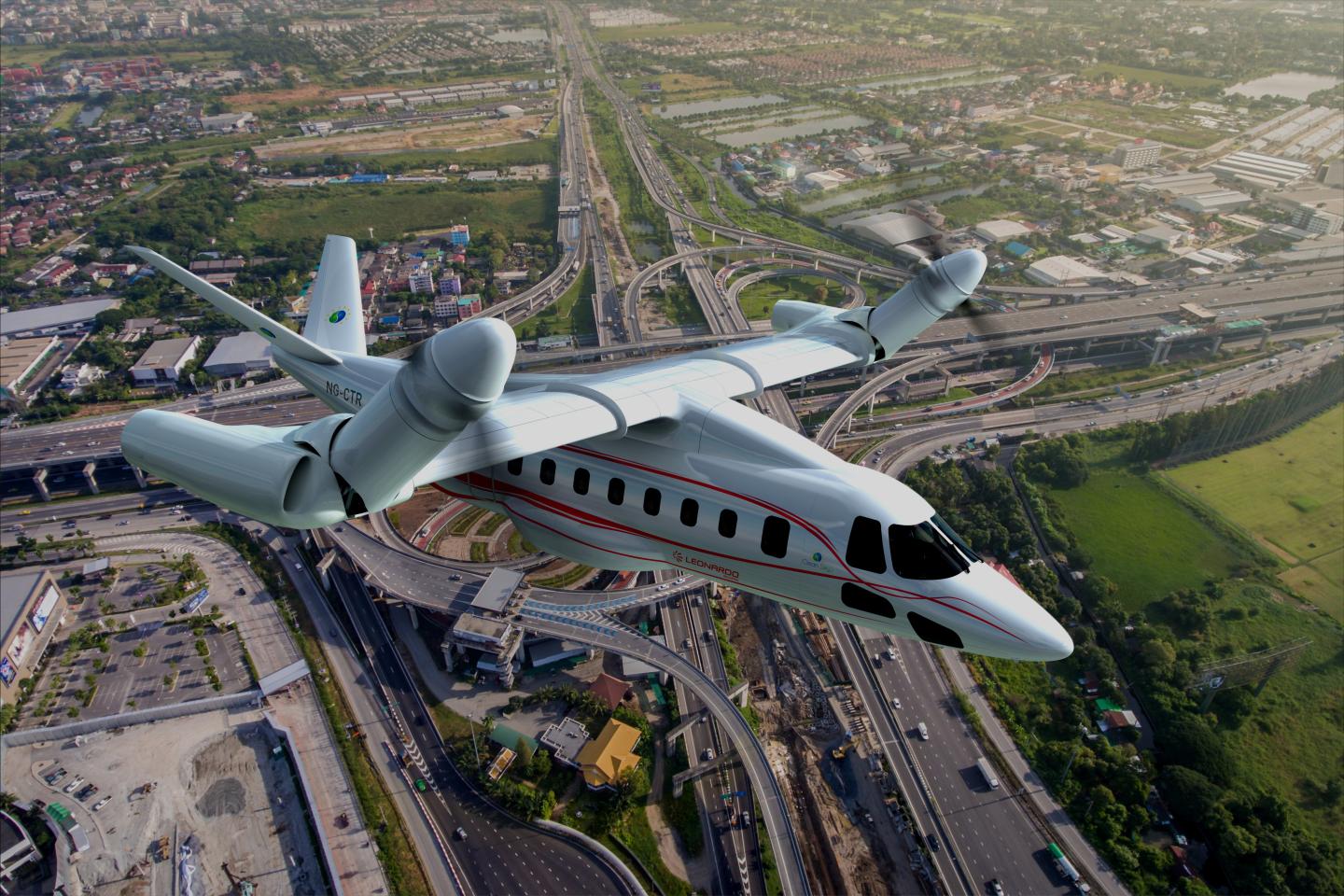
Credit: Leonardo
While NGRC is geared toward a clean-sheet design, this could ultimately be interpreted as precluding the acquisition of an upgraded variant of a currently operational military or civilian system. Beyond that restriction, some developmental or conceptual projects could be leveraged as a basis of the future medium multi-role helicopter with several already being proposed by industry. These include the Airbus Racer (Rapid and Cost-Effective Rotorcraft) concept for a high-speed vertical-lift aircraft, which is currently oriented toward civilian and public safety applications. The Racer design already meets some NGRC baselines including flight speed and inclusion of hybrid-electric power system; first flight of the technology demonstrator is expected in 2023. Another potential starting point could be the Next-Generation Civil TiltRotor (NGCTR) being developed by Leonardo, which is designed for a cruising speed of 519 km/h (280 kn) and range of 1,852 km (1,000 NM), with a (civilian) passenger capacity of 18-25. The first flight of the demonstrator is expected in 2024.

Credit: Airbus
Leonardo is also cooperating with Sikorsky to evaluate the suitability of the American firm’s X2 rotorcraft technology for the European market. The technology forms the backbone of several Sikorsky designs including the SB-1 Defiant, which ultimately lost the competition for the US Army’s FLRAA contract. Sikorsky is now concentrating on the international utility helicopter market. “We certainly think that the X2 fits very well with a number of the requirements that they [the NGRC programme] have, and we will continue to work that as time goes on,” said Sikorsky president Paul Lemmo. All three of the referenced designs would fulfil predictions made by many industry observers and corporate representatives who point out that the high speeds required of the NGRC will require an unconventional design, perhaps including a pusher propeller in addition to the main rotor, or a tiltrotor design.

Credit: Lockheed Martin/Sikorsky
NGRC – Moving Forward
The concept phase will provide the participating nations with some early design proposals, before tackling the development stage and the preliminary design review post-2025, according to Heckel. The goal is to exit the concept phase with two or three competing designs suitable for further development and evaluation going forward. The preliminary design review will be followed by award of development contracts. The programme office is recommending prototype testing as part of the development phase. NSPA’s Heckel estimates that prototype testing could take place around 2030.
Given the early stage of the programme, timelines for future NGRC stages are tentative. Advancing to a full development phase will require a new government-level agreement among the participating nations. Such an agreement would address such – potentially challenging – issues as division of work among the nations, design details, and the possible admission of other NATO members as full partners in the programme. Some points of contention regarding performance requirements – which will in turn impact factors such as size and cost – are already coming to the fore. For example, the priority given by the UK and Italy regarding high flight speeds is not shared by the French Army. Airbus warned early on that the 25 priorities presented by the programme office would require a larger, heavier and potentially more expensive aircraft. Trade-offs must be expected as the programme progresses. The programme office is adamant that a multitude of national variants should be avoided, as this could lead to sustainment issues and higher costs.
Optimally, there should be a single airframe and the modular design should enable aircraft to be refitted for various mission types as needed. Two variants are considered the maximum acceptable outcome if the full spectrum of operations cannot be achieved by a single design.
For the duration of the concept phase, the programme is restricted to the current seven members. After 2025, when a development decision is made, the programme is likely to open up again for additional participants, bringing in additional design and production resources, but potentially complicating decision-making and consensus going forward. Presuming that the programme is not terminated prematurely, and leads to a production decision, Alliance nations not participating in the programme will still be eligible to acquire the NGRC, greatly enhancing interoperability and potentially leading to lower unit costs.
Conversely, none of the seven current programme members will be required to procure the NGRC. Should the production schedule be delayed, or the aircraft’s profile not meet a nation’s specific requirements, other options will be available, including the US military’s new FLRAA.
The first operational aircraft are expected to enter service somewhere in the 2035-2040 timeframe, with a target of 2035. Given the large number of helicopters due to retire between 2035 and 2050, an Initial Operational Capability (IOC) later than 2035 would run the risk of creating a capability gap in at least some Alliance fleets. Current expectations foresee production and procurement running through 2059, with at least three major block changes during this timeframe to accommodate major technological developments and operational requirements. Once fully operational, the NGRC aircraft family is expected to dominate non-US medium rotary-lift aviation into the late 21st century.
Sidney E. Dean





